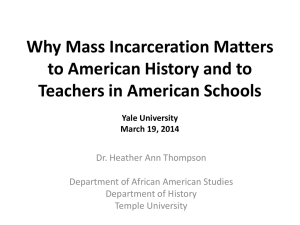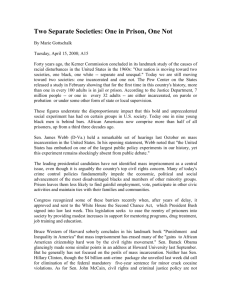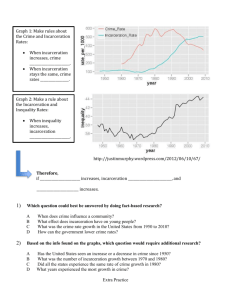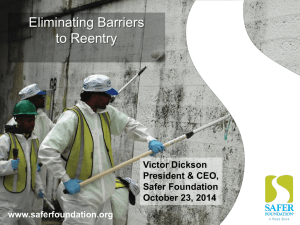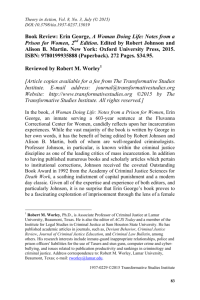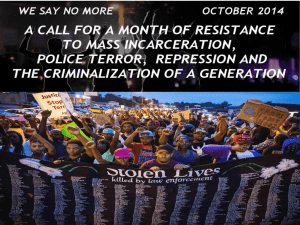ASSOCIATION FOR CRIMINAL JUSTICE RESEARCH (CALIFORNIA)
advertisement
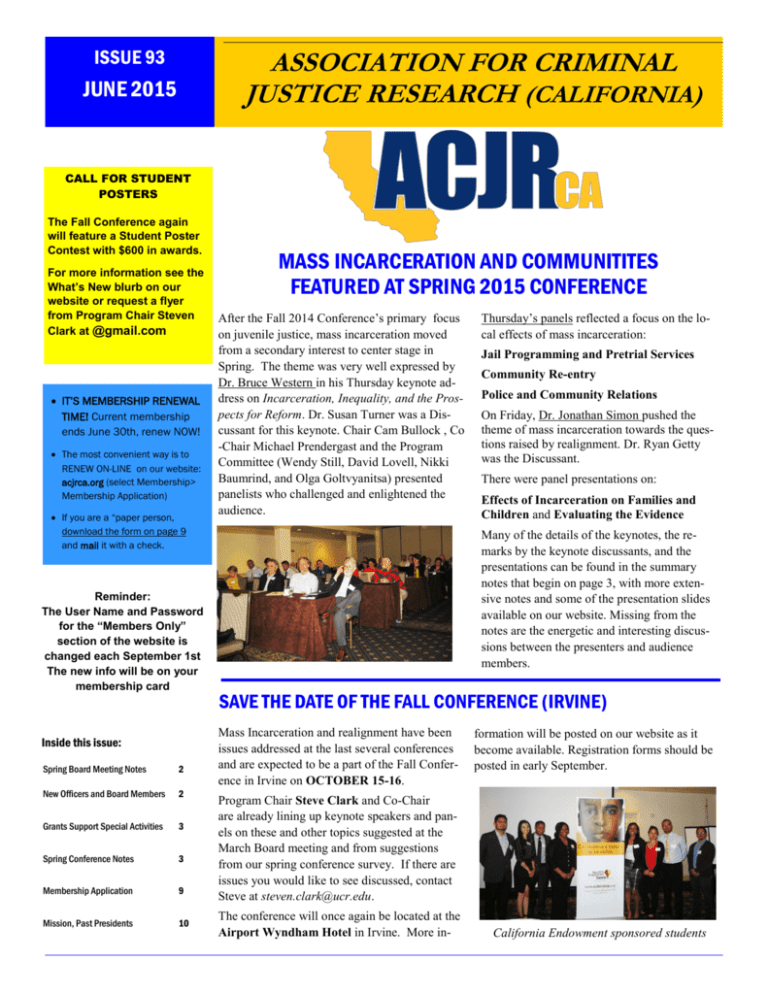
ISSUE 93 ASSOCIATION FOR CRIMINAL JUSTICE RESEARCH (CALIFORNIA) JUNE 2015 CALL FOR STUDENT POSTERS The Fall Conference again will feature a Student Poster Contest with $600 in awards. For more information see the What’s New blurb on our website or request a flyer from Program Chair Steven Clark at @gmail.com IT’S MEMBERSHIP RENEWAL TIME! Current membership ends June 30th, renew NOW! The most convenient way is to RENEW ON-LINE on our website: acjrca.org (select Membership> Membership Application) If you are a “paper person, download the form on page 9 and mail it with a check. Reminder: The User Name and Password for the “Members Only” section of the website is changed each September 1st The new info will be on your membership card Inside this issue: Spring Board Meeting Notes 2 New Officers and Board Members 2 Grants Support Special Activities 3 Spring Conference Notes 3 Membership Application 9 Mission, Past Presidents 10 MASS INCARCERATION AND COMMUNITITES FEATURED AT SPRING 2015 CONFERENCE After the Fall 2014 Conference’s primary focus on juvenile justice, mass incarceration moved from a secondary interest to center stage in Spring. The theme was very well expressed by Dr. Bruce Western in his Thursday keynote address on Incarceration, Inequality, and the Prospects for Reform. Dr. Susan Turner was a Discussant for this keynote. Chair Cam Bullock , Co -Chair Michael Prendergast and the Program Committee (Wendy Still, David Lovell, Nikki Baumrind, and Olga Goltvyanitsa) presented panelists who challenged and enlightened the audience. Thursday’s panels reflected a focus on the local effects of mass incarceration: Jail Programming and Pretrial Services Community Re-entry Police and Community Relations On Friday, Dr. Jonathan Simon pushed the theme of mass incarceration towards the questions raised by realignment. Dr. Ryan Getty was the Discussant. There were panel presentations on: Effects of Incarceration on Families and Children and Evaluating the Evidence Many of the details of the keynotes, the remarks by the keynote discussants, and the presentations can be found in the summary notes that begin on page 3, with more extensive notes and some of the presentation slides available on our website. Missing from the notes are the energetic and interesting discussions between the presenters and audience members. SAVE THE DATE OF THE FALL CONFERENCE (IRVINE) Mass Incarceration and realignment have been issues addressed at the last several conferences and are expected to be a part of the Fall Conference in Irvine on OCTOBER 15-16. formation will be posted on our website as it become available. Registration forms should be posted in early September. Program Chair Steve Clark and Co-Chair are already lining up keynote speakers and panels on these and other topics suggested at the March Board meeting and from suggestions from our spring conference survey. If there are issues you would like to see discussed, contact Steve at steven.clark@ucr.edu. The conference will once again be located at the Airport Wyndham Hotel in Irvine. More in- California Endowment sponsored students Page 2 ASSOCIATION FOR CRIMINAL JUSTICE RESEARCH (CALIFORNIA) SPRING BOARD BUSINESS MEETING NOTES - March 26th Since Minutes are now approved by email, the meeting began with introductions and the election of officers and new Board members (see below). The Fall Conference Chair position was open and names were suggested. Grant Committee: The Grant Committee secured funds from two sources to cover the costs of bringing a keynote speaker from the East Coast and to sponsor eight students (see article, page 3). Conference Report: Ann reported that registration included 88 paid registrants, 8 Endowment students (article page 3), and 17 non-registered panelists. Estimated revenues and costs were $8,100 and $8,000 (actual were $7,866 and $8,385, with some of the deficit covered by a grant). Cam Bullock thanked all those who help in putting together the program and materials. Wendy Still was thanked for securing a grant to cover keynote expenses. The enrollment of Endowment students was very successful, including lunch with Cory and Jim that encouraged continued participation. There was still little participation of student posters. Fall Conference Discussion: After some discussion regarding possible conference chairs, a number of topics for the Fall Conference were suggested. It was suggested that a crime survivor who could speak on her/his experiences might be a good keynote speaker. Membership: Membership numbers were similar to last year: 78 members, but just one student. Financial Report: The Association continues to be in excellent financial shape, with substantial reserves. Ann presented a preliminary financial report and proposed 2015-16 budget. Jim Hess proposed and the Board concurred that the increased workload of the Executive Officer warranted another $500 increase in stipend. Website/Marketing: Lou Moore and Mike Stefanko continue to keep the website updated. They hope to get feedback on a revised site over the summer. Additional funds were approved for website security. Jim Hess obtained the services of a graphic designer who created logos and two flyer templates. YOUR SUPPORT NEEDED TIME TO JOIN OR RENEW MEMBERSHIP Memberships support our newsletters and website, and also cover the work of organizing our semi-annual conferences. Members receive reduced conference fees and access to additional information on our website. A MEMBERSHIP/ RENEWAL FORM IS ATTACHED TO THIS NEWSLETTER (p 9) to print and mail. OR you can go to Spring Conference 2016: The dates of March 17-18 were chosen with the CPRW meeting the day before. The discussion focused on the problems with the hotel. Ann reported that a very productive meeting was held with the Director of Sales and Marketing that resolved many of the issues. With the pricing and other positives, it was decided to book the hotel again next year. New Business The GEO group proposed making a donation to ACJR to support the California Probation Research Network. Concerns of conflict of interest led to the decision that any donation should be made directly to CPRW. Steve Clark and Carolyn Eggleston will draft a donation policy to present to the Board, Rudy Haapanen reported that the American Justice Institute was disbanding and would like to turn over about $5,000 of its funds to ACJR to continue the presentation of the McGee Award. The Board agreed to accept the funds if offered. our website, then Select Membership, and then Membership Application. Complete, submit, and then pay THROUGH PAYPAL. CALL FOR STUDENT POSTERS If you interact with students studying criminal justice issues, encourage them to enter the student poster contest. Flyers are available through our website. OFFICERS AND BOARD MEMBER ELECTED FOR 2015-16 The following candidates for Officers for 2015-2016 were approved by the Board at the Business Meeting: President: Campbell Bullock, Executive Director, San Joaquin Community Data Co-op Vice-President—South: pending (later accepted by Steve Clark, Director, Presley Center, UC Riverside) Vice-President—North: Jon Caudill, Assistant Professor, Department of Political Science, Cal State University, Chico Secretary-Treasurer: Jim Hess, Statistician/Analyst, Center for Evidence-based Corrections, UC Irvine (two year renewal) All terms begin July 1, 2015. The following Board members were elected (or re-elected) to three year terms: Francine Byrne, Carolyn Eggleston, Shirley Hunt, Tom G Hoffman, Mikaela Rabinowitz, Mary Lou Vachet Continuing Board members are: Cam Bullock, Jon Caudill, Steve Clark, Frances Coles, Lois Davis, Christine Gardiner, Jim Hess, Melissa Johnson, David Lovell, Tomar Mason, and Kevin O’Connell As past presidents, Amanda Noble and Elizabeth Siggins and Cory Woods (as of July 1) are ex-officio Board members. ISSUE 93 Page 3 GRANTS OBTAINED TO SUPPORT SPECIAL CONFERENCE ACTIVITIES; DONATIONS TOO Two grants were obtained by Board members to fund special activities at the Spring Conference. Wendy Still secured the agreement of Dr. Bruce Western of Harvard to attend as our Thursday keynote speaker, then obtained funding from the Rosenberg Foundation to cover the expenses of the trip. Lois Davis and Elizabeth Siggins prepared a successful proposal to the California Endowment to enable us to pay all the costs, including travel for eight “students of color” to attend, four each from Northern and Southern California (pictured on page 1). These student found the presentations, networking and variety of work being done all very exciting. After lunching with Cory Woods and Jim Hess, they agreed to continue to participate in the Association and encourage other students to do so as well. The Association also received $643 in donations from six members, with a primary focus on funding expenses for students. This enabled the Association to cover the lunches for seven other student attendees. As a 501©(3) non-profit, donations are tax deductable. CONFERENCE NOTES The following are a highly summarized set of notes taken by Mike Stefanko, PhD of the presentations made at the 81st Semi-Annual Meeting of the Association for Criminal Justice Research (California) reflecting points that attracted his attention. More detailed notes can be found on our website (www.acjrca.org), along with .pdf files of most presentations. THURSDAY KEYNOTE ADDRESS: Bruce Western, Guggenheim Professor of Criminal Justice Policy, Harvard University, “Incarceration, Inequality, and the Prospects for Reform” President Cory Woods welcomed everyone and noted that a Rosenberg Foundation grant enabled Dr. Western to be our keynote speaker. Program Chair Cam Bullock introduced Dr. Western, who began by noting that mass incarceration has led to the abandoning of rehabilitation and a 5X growth in prisons, a well as changing the landscape of poverty. Dr. Western’s background includes a mother from Thailand who saw the incarceration of “outsiders” often just for being “outsiders.” Incarceration rate data from developed countries was displayed, running from about 60 to 150 per 100,000. In contrast, the incarceration rate for the United States is about 700 per 100,000. Dr. Western noted that between 1925 and 1972, the U.S. rate was about 100 per 100,000. Currently 6.9 million persons are under some form of supervision (1.57 million in prison, 700,000 in jails, 850,000 on parole and 3.9 million on probation). The chances of staying out of this system show vast differences by race, especially for the less educated. For the cohort born between 1945 and 1949, the data show incarceration figures among those with high school or less education as 1.8% for whites and 12.1% for African-Americans. For a current cohort those figures change to 6.3% and 35.7% respectively, rising to 69% for African-Americans with less than high school. Dr. Western cited three intractable reasons for the inequalities created by mass incarceration. First, the population is invisible: concentrated in areas away from the general population, segregated within the prisons, and overlooked in social accounting. For example a generally cited percentage of employment using households is 45% for African Americans, but when the incarcerated are included the figure drops to about 25%. The second reason is that effects are cumulative. This population is under-employed and earns low wages. After incarceration earnings drop 40%. Employment opportunities for those with a criminal record are one-half to one-third of those for persons without records. Upward mobility in wages is much less. The third intractable reason is that effects are intergenerational. Children with incarcerated parents display more behavioral problems than other children. By age 14, one in four AfricanAmerican children has a parent in the system. Mass incarceration has created a new social group of chronically poor persons with many obstacles to full membership in society and with little trust in the police or the courts. Dr. Western believes that the first step in breaking this cycle is for the full members of society to see themselves in the marginalized. He showed some videos of a man released after years in prison. He was born in a poverty neighborhood to a drug-addicted mother and an absent father, with addicted, combative uncles for role models. The man noted that people were both offenders and victims. Spring Conference Now he lives in crowded housing and has a minimum wage job, with life a daily struggle. How much can we change? A story of a researcher in Ethiopia provides insight. He accidently hit and killed a child while driving through a village. With no local police, vilreturns to lagers took care of these matters. The researcher was allowed to leave, being told to return when called. He was told to pay the family the equivalent of $125 and to buy a goat. The goatLion’s was slaughtered a ritual binding him to the child’s father. This made him a Gatein Hotel member of the family, with the obligations of a family member. We need to think of alternatives to incarceration that would make March offenders more a part of our “families.” We need to stop thinking,of2014 violent people and start thinking of violent contexts, working to change these contexts. Europe has some ideas that should be discussed, getting district attorneys and chiefs/sheriffs on board. We need to address childhood health, especially in the area of traumatic experiences. DISCUSSION OF THE KEYNOTE: Susan Turner, Director of the Center for Evidence-based Corrections at UC Irvine, led the Page 4 ASSOCIATION FOR CRIMINAL JUSTICE RESEARCH (CALIFORNIA) discussion of the keynote address. She began by noting that California is about average in our rates of incarceration. We are trying to reduce the prison population under court direction, and increase the use of alternative sanctions due to jail capacity issues. AB900 and SB18X3 utilized some offense-based risk assessment to lower some of these numbers. Realignment attempted a more dramatic reduction but has been blunted by a compliance focus rather than one on “justice.” A major problem with the offense based realignment approach is that these offenders have higher rates of recidivism in part due to more serious previous crimes. The use of risk has met with resistance and some backlash. These comments were followed by a more general discussion involving the audience. PANEL #1: JAIL PROGRAMMING AND PRETRIAL SERVICES Moderator David Lovell noted that the number of persons who spend some time in jail is five times the current jail population. We need to focus on all these persons to determine who needs to be kept in jail and who does not. Up to 60% of some jail populations consist of people waiting for a time in court: arraignment, plea, trial, or sentencing. Stephanie James, the Chief of Probation for San Joaquin County, spoke about trial services. The attempt to utilize alternative programs in her county took a hit when two released parolees immediately committed heinous crimes. Officials needed to looked beyond the immediate offense and take into account the offender’s criminal history before deciding on release. The pretrial risk assessment tool needed validation. A grant for technical assistance aided in these efforts. Chief James strives for transparency and inclusiveness in the discussion process. For example, the ACLU became a key partner. There has been a year of weekly meetings among many top officials. Currently the Virginia Pretrial Assessment instrument is being used for felony and more serious misdemeanor offenders. There is a monitoring program to match service level with risk level. Those with the lowest risk scores get phone call reminders, with the next level required to call in once a week, and weekly appearances required of the third level. The highest level is kept in custody until their initial court appearance, and then they are placed on electronic monitoring. This has led to having enough open beds to avoid early release of those sentenced. A side benefit has been the increased acceptance by judges of sheriff and probation recommendations. Implementation has gone smoothly, with widespread support. Geoffrey Henderson, an Administrative Manager with the Orange County Sheriff’s Office, focused his remarks on in-custody substance abuse programs, specifically the New Start Program. The primary goal of the program was to reduce recidivism through voluntary integrated substance abuse treatment. Case managers follow the 64 medium to high risk men. Services include that of a family therapist, since family support is key. Trained recruiters are needed to get good volunteers. The program uses the modified therapeutic community and 12 step models, plus stages of change, relapse prevention, and a continuum of care. Six months would be ideal for the program, but the average offender is released after 80 days. The program then moves to transitional housing followed by outpatient support for 12 months. An interesting aspect of the program is the use of visual representation (art work, a mural) of things the person has difficulty in verbalizing. Post-custody services include emotional literacy work and trauma protection. The Office was able to create a good comparison group. In the first six months after release, program participants had a 29% level of recidivism versus 45% for the comparison group. At 12 months the figures were 48% versus 61%. Geoffrey displayed a slide showing the demographics of the program group. This was the first program experience for over 50% of participants. Estimated savings were $2 million per year. Next was a brief description of the Positive Impact on Youth program that focuses on high risk parolees 18 to 25 years of age. Active case management and a long list of support services emphasizing treatment and education were keys to this program. Recidivism was low. Delores Lyles, the Program Manager of Centerforce spoke next. Centerforce began three years ago by coming to the Alameda County jail with an array of services. It now serves all of California. Ms. Lyles focused on the effect of incarceration on women and their families. There is a major effect on children, with care often shifted to people they don’t know, even if they are family members. Centerforce received federal funding to bring best practices and trained staffing to prisons and jails, finding a disconnect between the Centerforce focus on rehabilitation and the desires of the facility staff for safety and security. Ms. Lyle noted that women are often arrested for trying to support themselves through drug dealing, which overlaps with using. With no resource to post bail, they sit in custody for long periods. Centerforce begins by finding out where the children are (most mothers do not know). A plan for how to reunite the children with the mother comes next. By developing a relationship with the mother through a focus on her children, Centerfoce staff can get the mother into this voluntary program. The program began with women assessed as medium risk, but now includes high risk women. These latter women are in custody for longer period, giving Centerforce more time to develop plans. Staff persons can facilitate phone calls and visits. With chaotic pre-custody lives and multi-generational drug involvement, stable housing became the most helpful service that Centerforce could provide. Financial independence is often more of a challenge than maintaining sobriety. After stable housing, the development of communication skills helped these women to repair family relationships. Other aspects of the program improve self-awareness and accountability. A case plan of up to 18 months is developed for each woman, which includes therapy. PANEL #2: COMMUNITY RE-ENTRY Moderator Wendy Still introduced the panelists and turned the program over to Francine Byrne, Supervising Research Analyst, Administrative Office of the Courts, who spoke on the Parole Reentry Court Project. Prior to 2009 legislation focusing on substance ISSUE 93 Page 5 abuse and mental health issues, the courts had had little interaction with parolees. Interviews, site observations, and focus groups were used to evaluate the project. A comparison group was created and parolees were tracked for two years after release. Data showed the project reaching its intended population. While program group members had more re-arrests than the comparison group (78% versus 65%), fewer had their parole revoked and fewer were returned to prison (average 17 days versus 59 days). One reason for higher re-arrest numbers was the use of “flash incarceration” early in the project. Demographics of participants included: average age of 38, 81% male, 43% African-American, 28% white, and 23% Latino, with a high risk of reoffending and many mental health issues (37% having a diagnosed condition). 99% had substance abuse issues, with 45% using for over 20 years. Focus group discussions indicated that childhood trauma was widespread among program participants, who had tried to mask symptoms while incarcerated so as not to be isolated. The post-realignment population was different from that prior to realignment, leading to needs to adjust the program. Adey Nyamathi, from the UCLA School of Nursing, talked about the many homeless persons with substance abuse and mental health issues who are incarcerated, leading to large numbers of parolees. Coaches with the Amity program (Amistad de Los Angeles) work alongside nurses in treating parolees. Offenders with substance abuse issues are two to four times as likely to reoffend. By raising self-esteem, a program can improve the threat appraisal skills and coping behaviors of such offenders. Three treatment modalities were tested: 1) weekly peer coaching plus nurse case management; 2) peer coaching alone; and 3) a few brief sessions of coaching plus case management. The program participants had extensive chemical histories: over half had begun as juveniles. Over 50% had been in prison more than five times. The program was designed to last six months, but most participants were in the program for three months or less. No significant differences in the amount of re-arrest were found between the three modalities, but those in a program for the full six months had lower rates of re-arrest. A side effect was a dramatic increase in the rate of vaccination for hepatitis (HAV and HBV) from 12% to 73%. Jennifer Scaife, the Director of the Reentry Division of the San Francisco Probation Department, reported on the Reentry Council of San Francisco. This collaboration consisted of 23 members of all relevant agencies and included the formerly incarcerated. There are three subcommittees working with community members (see sfgov.org/rentry). There also is a Community Corrections Partnership, a Sentencing Commission, and a Juvenile Justice Coordinating Council. These groups all participate in the Justice Reinvestment Initiative. Initiative goals include: eliminating racial disproportionality, expanding pretrial alternatives to jail, and implementing riskbased supervision. Work on pretrial alternatives has reduced jail counts to 40 year lows, while risk-based supervision has reduced supervision time from a universal 36 months to 24 months for medium risk offenders and 18 months for low risk offenders. There has been an increase in treatment matching and in program quality. Service gaps have been identified leading to discussions about shifting resources. Forty-one percent of this population has been assessed as high risk and most have co-occurring high needs. Four of the highest needs have been: changing criminal thinking, treating substance abuse, finding stable housing, and learning how to address criminal peers. About 30% have identifiable mental health issues. Providing participants with a list of available services have helped them show up for assistance, including case management, employment assistance, and substance abuse treatment. The collaboration among agencies and the communication within the Reentry Council has improved the training of line staff through sharing of capabilities. Data sharing has also been dramatically improved. Tools for better decision-making have led to better outcomes. PANEL #3: POLICE AND COMMUNITY RELATIONS Moderator Elizabeth Siggins noted that our expectations of the police are daunting. The willingness of police departments to embrace challenges has led to the development of many innovative things. Chief Eric Jones of the Stockton Police Department, noted that effective community-police relations are never destinations; but always a process. Five years ago the city’s fiscal emergency led to a one third cut in his department, to become the most understaffed force in the nation. They became a “911 department,” capable only of responding to calls and basic patrolling. Gone were special teams and programs, including most community meetings. This led to a need for fair, impartial policing that focused on protecting the rights of all. Cynicism was combated: 1) by creating a community advisory board, 2) by implementing regular community forums, and 3) by having the city manager and chief conduct private meetings in response to crises. There was training in the areas of racial disparity and the perceptions of police as an arm of the government. Youth outreach programs and the use of body cameras attempted to show the population that service was as important as protection. Adapting Boston’s Ceasefire program to the Stockton situation, the message “gun violence must stop” was adopted by all agencies and throughout the community. Ceasefire also brought strategies based on data-driven enforcement techniques. The principles and strategies adopted by the Stockton Police Department have led it to be named the only California city to receive funds as part of President Obama’s Trust Initiative, bringing in research partners to determine the effectiveness of current efforts and assistance in determining how to proceed. Pastor Les Simmons presented a community perspective. The City of Sacramento created a version of Boston’s Ceasefire program in 2010 with Page 6 ASSOCIATION FOR CRIMINAL JUSTICE RESEARCH (CALIFORNIA) a focus on identifying the “shot callers” in gangs, rather than devote scarce resources on affiliates, “wannabes,” or regular gang members. Shot callers were brought together with those who had been affected by violence, resulting in a decrease in gun cases and homicides. Faith communities united in an effort to make neighborhoods safe for their parishioners, with a key being a series of “night walks.” Hundreds of parishioners would walk together through the streets of troubled neighborhoods, asserting their rights to be safe. A group, Cops and Clergy, was formed in 2013 to build trust through transparency and accountability. This gave police access to church communities, where meetings could occur to share information and listen to concerns. These church communities also became hiring centers for the police department. Now there are fifty clergy involved. Pastor Simmons went to Ferguson, Missouri and saw the need for police-community relations. The fruits of the effort to improve relations came after a period called “March Madness” when there were 17 shootings in a short time span. Through the use of flyers and social media all eight participants in the violence were identified and arrested. Churches, the police department and health care agencies recognize that they have a common goal of saving lives and work together to provide alternatives such as sports activities and food fairs. Clergy have gotten to know what the police experience. The keys to these successes were: transparency, building relationships, accountability, and trust. Nancy McPherson, AARP Interim Director began by noting that AARP focused on all issues that affected those aged 50 and over, many with active lifestyles. Ms. McPherson stated that her background included work as a civilian with a police department and that she had worked in New Orleans after hurricane Katrina in rebuilding communities. Things improved post-Katrina when outside help was able to work with police and those in the community. Sustainability was a key issue. AARP assists seniors in their local communities to make those communities safe environments capable of listening to and addressing the needs of seniors. Ms. McPherson used the community of Holygrove in New Orleans as an example. It was a high crime area before Katrina. Once the eight feet of water receded, 6,000 residents returned, 1,000 of them AARP members. After a program uniting the community, there was a 70% reduction in violent crime. The program began with the formation of a steering committee. A door-to-door survey was conducted and people were invited to participate in a community-building academy. Four projects were created: a Mobility and Transportation Project, a Public Safety and Resident Engagement Project, an Economic Development Project, and a Health and Caregiving Project. A Hot Sheet was created for residents to report suspicious activity. A key focus was in ensuring that the main offenders were not released after arrest. A walking club was established both to improve the health of residents and to identify problems in the neighborhood that needed attention. There are now 16 walking clubs throughout New Orleans. While the police department struggled to rebuild, AARP hired crime consultants, who initiated the concept of directed patrols. Because conditions are so different elsewhere, the Holygrove experience has not been replicated, although groups of volunteers have been organized. Ms. McPherson hoped that more communities would take the positive aspects of Holygrove and adapt them to their own situations. Surveys indicate that only 16% of local governments are creating communities that are good for 50+ year olds. AARP has described eight domains of livability that government and community activists should address. These domains focus on evidence-based policies. It is strongly encouraged to have a neutral convener among the groups discussing how to proceed. Frederico Rocha, Undersheriff of the San Francisco Sheriff’s Department, discussed his experiences in East Palo Alto, a community that needed a “do-over” to build trust in the police. There are about 25,000 residents, 94% were people of color. 64% were Latino, many undocumented. Mr. Rocha looked at the issues from the perspective of violence as a public health issue. A California Endowment grant allowed the hiring of an epidemiologist from UC Berkeley. After mapping the location of shootings, the two worst areas were determined, with over 5200 reports of gunshots and much lower life expectancies. Law enforcement focused on meeting with women with children. Activities for the children were provided as discussions occurred on various health issues. About 10 women were expected, but over 50 attended. To help change perceptions of the police, officers attending these meeting wore different (nonblue) uniforms and showed up on bikes rather than in patrol cars. With new impressions of police, participant took the lead in actions within the community. There was a 40-60% reduction in report gunshot following the series of meetings and discussions, without any arrests. An auxiliary effect was increased enrollment in Affordable Care Act programs. Once reluctant, officers now jump at the chance to volunteer to participate in these meetings. PRESIDENT’S REPORT AND POSTER AWARDS: Cory Woods reported that the Association was in excellent condition financially and encouraged those in attendance to support it by becoming members. He presented the student poster awards. Dr. Ryan Getty introduced the Friday keynote speaker. FRIDAY KEYNOTE ADDRESS: Jonathan Simon, Director of the Center for the Study of Law and Society, University of California, Berkeley: Realigning Criminal Justice Research: Asking the Right Questions after Mass Incarceration. Dr. Simon noted that when the country was in a prison-building mode, research did not mean much to policymakers. We moved away from widespread rehabilitation and towards increased punishment and degrading treatments. Racial concentration deepened. California moved from the second lowest incarceration rate in the late 1980’s to the second highest rate currently Brown v Plata is one of the least recognized major cases in prison reform. Justice Kennedy’s strong language about inhumane treatment included the term “deliberate indifference.” If research had counted with policymakers, mass incarceration would ISSUE 93 Page 7 not have happened. Dr. Simon cited Sheldon Messinger and Caleb Foote as leading researchers who determined that use of bail and sentencing reform were needed. Studies by RAND concluded that selective incarceration was more effective than mass incarceration, a doubling of the prison population would lead to only about a 5% reduction in crime. Dr. Simon then provided some history, beginning with the legality principle in the 3rd century: if there is no law in place, there is no crime. Since then there have been shifts between a more democratic approach (justice for “the masses”) and a more bureaucratic one (to reduce violence). In the last 40 years we have extended legality, but have allowed prison bureaucracies to become more insular, leading to more inhumane treatment. A second consideration is the loss of Western values. We need to focus on dignity as a core responsibility throughout the criminal process from surveillance through arrest, jail, bail, incarceration, and probation/parole. There need to be limits on the length and conditions of punishment. Pretrial detention became a fast way to get people off the streets, making the public feel safer. Prisons were located away from communities. The use of solitary confinement increased. The United States, as opposed to Europe, did away with notions of special treatment for the aristocracy, but equality meant leveling down. The sentence of Life Without Parole, now banned in Europe, is applied to tens of thousands of prisoners here. Dignity versus legality also is an issue of human rights versus the State as client, procedural justice versus due process, recidivism versus well being, protection from crime versus protection from the social responses to crime, and, finally, crime policy versus crime politics. DISCUSSION OF THE KEYNOTE: Ryan Getty from California State University, Sacramento suggested that one way to merge crime policy and crime politics is to get the politicians, policymakers and judges to visit prisons and interact with prisoners and corrections staff persons and see how sentences are applied. The events in Ferguson show that people understand legality, but this policy results in an overly harsh response by the police. For example, district attorneys stack charges in order to generate plea bargains and guilty pleas. There is a perception that there are so many criminals, and since we can’t rehabilitate them, we need to lock them away for as long as possible. Perhaps the most important, note is that there is a generational gap in the view of safety in society. In general, “Millennials” have a view that society is much safer than the view held by “Boomers.” PANEL #4: EFFECTS OF INCARCERATION ON FAMILIES AND CHILDREN Moderator Carol Burton of the Jeweld Legacy Group observed that incarceration had a devastating effect on some communities. Project SEEK is a longitudinal study of the children of incarcerated parents that found that these children’s lives were most affected by broken promises and the effects of their parents’ substance abuse. However, the more times a child visited an incarcerated parent, the more that parent desired to do better. A series of recommendations made 25 years ago regarding improving both the lives of these children and the parenting skills of the incarcerated parent are still waiting to be implemented. Children are the best defense against recidivism. Barbara Bloom, a Professor of Criminology at Sonoma State University, focused on collateral consequences of mass incarceration. As early as 1976 The House at San Quentin was established for children to visit incarcerated parents but few visits occurred. In 1993 there was a follow up to a work entitled Why Punish the Children? This survey of 439 incarcerated women found that 40% were in custody because of drug offenses and that they had an average of 2.6 children with whom they hoped to reunite. Over half the children had never visited their mother, distance being the main factor. Visits were even less likely if the child was in the foster care system for there are no incentives for a foster parent to bring a child for visits. Dr. Bloom felt that the public needed to be better educated about this situation. Visits help the caregivers as well as the children. Sentencing options and support services need to be expanded. The problems increased dramatically over 30 years with a six fold increase of incarcerated women. Racial disproportion is great: one in twenty-eight children have a parent in prison, but one in nine African-American children is in that situation. About 1.3 million children have a mother under correctional supervision. These children are at increased risk of problems at school, emotional and cognitive difficulties, lower GPAs and graduations rates, and increased likelihood of future incarceration. Many of the risk factors predate incarceration, but incarceration is another traumatic event. There are negative consequences on caregivers: financial, physical and emotional. A 1997 act causes parents to lose their parental rights if they do not have contact with their children. Upon release, parents face great difficulties in finding housing and employment. Support for these children should focus on fostering resilience and increasing peer support. Dr. Nena Messina from the Integrated Substance Abuse Programs at UCLA discussed the impact of visitation transportation services. Funding from the California Endowment and the Lloyd Society enabled Dr. Messina to study registration forms for the Chowchilla Family Express, a bus service taking family member to visit women in the prison at Chowchilla. This information was combined with data from interviews with caregivers and surveys of focus groups and mothers. This pilot study involved 69 incarcerated mothers, 54% Hispanic and 40% African-American. Fifty-eight percent had been unemployed and 52% had never been married. In 60% of the cases, the child’s father was also incarcerated. Fifty-four percent had been diagnosed with a mental illness. Twenty-six caregivers were interviewed. Sixty-nine percent were grandparents of the children and 62% had health issues. Caregivers stated that half of the children had problems in school and 32% had behavioral problems. More contact with the mother correlated with decreases in behavioral problems and was associated with more financial aid. Physically seeing and touching the mother had a greater impact than letters or phone/Skype calls. Contact assisted the mother in adjusting to prison and helped them think of a life after prison. The Service Page 8 ASSOCIATION FOR CRIMINAL JUSTICE RESEARCH (CALIFORNIA) also facilitated getting into the prison, provided activities on the bus, and talked with the children on the ride home about their experiences. Repeat visitors often made friends with others on the bus. Limits to the study included the lack of interviews of the children and data that was self-reported descriptions from a limited sample size. Gretchen Newby from Friends Outside discussed the effects of parenting education programs for recently released women. The children of incarcerated parents are seen as the “walking wounded.” This included adult children as well. These children come from situations characterized by poverty and housing instability, and neighborhoods with poor schools and predators on the streets. With little access to healthy foods, obesity, untreated medical issues, substance abuse, and probable instances of PTSD are part of this environment. Research by Norm Holt led to the requirement that each prison have a visitor center. In 1955 the Quakers established Friends Outside to provide dignity and affirmation to released offenders. In the 1980’s parenting education was added to the Friends’ services to fulfill a court order. The program works because it begins with respect, uses games and exercises to build trust, and presents a structured and predictable environment that gradually leads to sharing. There are clear, age-appropriate expectations with varied intensity levels to maintain interest. Family roles and building empathy are important aspects. Recently a video featuring Sesame Street characters has been added to the program mix, illustrating how people have come to recognize the importance and effectiveness of this program. PANEL #5: PRESIDENT’S CHOICE – EVALUATING THE EVIDENCE Moderator Nikki Baumrind from the California Department of Public Health provided a little history of evidenced-based practices beginning with its roots in medicine. Evidence-based practices are based upon the best available scientific evidence. Scientific knowledge is always changing and expanding, so evidence-based practices will change a well: some dropped, others added, and some modified. Dr. Baumrind used an analogy to studies of whether parachutes reduce the amount of serious injuries. There has never been a double-blind study with a randomized control group that did not use parachutes to determine the effects in a scientific way. Jonathan Caudill from Cal State Chico and Butte County Sheriff Kory Honea described an implementation evaluation in Butte County that also involved Ryan Patten of Cal State Chico. Sheriff Honea was not enthused by the implications of realignment for his county, but knew he had to do something. He further knew that this “something” would involve organizational and cultural change. This change would be uncomfortable and the right kind of leadership would be critical: the right attitude, the right kinds and amounts of communication, and the correct matching of people with positions. Sheriff Honea developed a plan, brought in independent evaluators, and prepared to celebrate successes. Dr. Caudill and Patten, the independent evaluators, regarded the three foci for organizational justice: Distributive – how to be “equal”; Procedural – who does what and how is it done?; and Interactional – do the people involved feel that they are being treated fairly and with respect? The evaluation consisted of a cross-sectional survey done with a logistical regression. Necessity, Preparation, Proximity, Distribution and Public Safety were important elements of the evaluation framework. Necessity was correlated with Safety, which relates to “buy-in.” Preparation and Training were found to be keys to successful implementation. Drs. Daniel Blonigen and Rachel Kimerling presented findings on the challenges to implementing evidence-based practices in a Veteran’s Administration program to reduce recidivism among justice-involved vets. The VA program was based on a Risk -Needs-Responsivity (RNR) model. A Veterans Justice Program was begun in 2007 to determine alternatives to incarceration and linkages to needed services. There were Outreach and Reentry programs. A slide displayed the system model. Evaluators try to determine which practices should be guiding policymakers, including: the effective tools for assessing Risk; the dynamic factors to be targeted for Needs; and the cognitive/behavioral strategies to be employed as Responses. A key is to maintain program integrity across many different venues using implementation science. Structured interviews were conducted with 63 specialists. Sixty-two percent responded that effective risk assessment is useful in triaging clients, in treatment planning, and in support advocacy, but mainly in determining the intensity of case management. Ninety percent felt that further training was needed. Identified barriers included: lack of time and resources; the stigma of seeking services; assessments can hurt the alliances being established with the vet; and the potential of misusing or misinterpreting the results. Knowing these barriers assists in developing better implementation strategies. ISSUE 93 Page 9 ASSOCIATION FOR CRIMINAL JUSTICE RESEARCH (CALIFORNIA) Application for Membership or Membership Renewal July 1, 2015 – June 30, 2016 Name _________________________________________________________________ Preferred Email _________________________________________________________ Personal Phone _________________________________________________________ Work Phone ____________________________________________________________ Work Title _____________________________________________________________ Agency/School _________________________________________________________ Work Address ___________________________________________________________ City/State/ZIP __________________________________________________________ Mailing Address (if different) __________________________________________________ Mailing City/State/ZIP _____________________________________________________ We will be posting your name, work title, and agency/school on the membership rosters on our website. We will add contact information if you circle which ones we can add to either the Members Only roster and/or the Public Roster. Please circle each one you are giving us permission to include (circle both if both places are okay): Preferred Email Member Only Public Work Address Member Only Public Personal Phone Member Only Public Mailing Address Member Only Public Member Only Public Work Phone Please list up to four major areas of professional interest (our database has room for four). 1. ____________________________________________________ 2. ____________________________________________________ 3. ____________________________________________________ 4. ____________________________________________________ (Examples include: juvenile justice, corrections, drug abuse, program evaluation, courts, victim rights) ---------------------------------------------------------------------------------------------------------------------------Membership dues remain $45 again this year (just $15 for fulltime students)! To complete your membership, send this form and a check for dues payable to: Association for Criminal Justice Research (CA) Fairmont Station P.O. Box 2458 El Cerrito, CA 94530 OR GO TO OUR WEBSITE TO PAY THROUGH PAYPAL Most contact, including newsletters and conference registration information, will be by EMAIL. IF YOU WOULD PREFER TO RECEIVE PRINTED COPIES of these materials, CHECK HERE The Association for Criminal Justice Research (California) is a dynamic mix of public servants, practitioners, evaluators, analysts, academics, and students. These diverse groups are united by a common interest in looking at criminal justice issues from a data-driven perspective. Association for Criminal Justice Research (California) Fairmont Station P.O. Box 2458 El Cerrito, CA 94530 Phone: 510-527-0264 E-mail: agoolsby@berkeley.edu Visit us a www.acjrca.org Mission The mission of the Association for Criminal Justice Research (California) is twofold. First, the Association seeks to stimulate and improve research on crime, delinquency, and the justice system process. Second, the Association seeks to encourage cooperative relations among persons engaged in scientific research of criminal justice issues and those implementing research findings. All research performed by the Association is for the benefit of the general public. As an illustration of the diverse nature of our members, past presidents of the Association include: Sheldon Messinger, Professor, School of Criminology & School of Law, UC Berkeley I.J. Shain, Director of Research, Judicial Council of California Solomon Kobrin, Sr. Research Associate, Institute for Social Science Research, USC Floyd Feeney, Center on Administration of Criminal Justice, UC Davis Malcolm Klein, Professor, Sociology, University of Southern California Keith Griffiths, Director of Research, California Youth Authority Daniel Glaser, Professor, Sociology, University of Southern California Elaine Duxbury, Research Manager, California Youth Authority Peter Greenwood, Criminal Justice, The RAND Corporation James Galvin, National Council on Crime and Delinquency Joan Petersilia, Criminal Justice, The RAND Corportation James Austin, Director of Research, National Council on Crime & Delinquency Robert Cushman, American Justice Institute Steve Crawford, Bureau of Criminal Statistics Robert Dickover, Research, Department of Corrections Susan Turner, Criminal Justice, The RAND Corporation Gwen Kurz, Orange County Probation Susan Collins, Orange County Probation Christine Curtis, San Diego Association of Governments Dale Sechrest, Professor, Criminal Justice, California State University, San Bernardino Norman Skonovd, California Youth Authority John Berecochea, Director of Research, Department of Corrections Shirley Melnicoe, Executive Director, Northern California Service League Tomar Mason, Judge, San Francisco Superior Court Darlanne H. Mulmat, San Diego Association of Governments Lyn Angene, San Diego Superior Court Michael Stefanko, Orange County District Attorney’s Office Sandy Hilger, Orange County Probation; Superior Court, Orange County Frances Coles, Professor Emerita, Criminal Justice, CA State University, San Bernardino Amanda Noble, Senior Policy Analyst, CA Research Bureau (retired) Elizabeth Siggins, Senior Advisor, Rehabilitative Programs, CA Dept. of Corrections/Rehabilitation Cory Woods, Administrative Supervisor, San Bernardino County Probation Department
